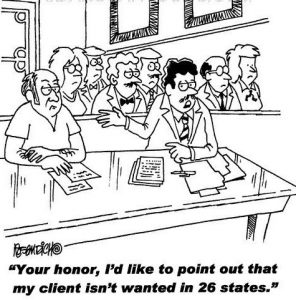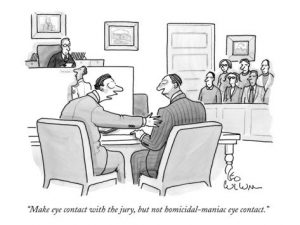Part III: The Courtroom—Guilty Plea and Trial
Part I and Part II of this series explore police procedure and constitutional rights during the investigation phase. Now, on to the really fun part! The courtroom. Writers: Your fictional perp is caught and indicted. It’s time to deal or go to trial.
Arraignment and Bail Hearing

First stop, arraignment on the indictment. For most cases, this includes a bail hearing. The purpose of bail is to guarantee the defendant’s appearance in court. The judge considers the seriousness of the offense, the defendant’s ties to the community, criminal record, and any history of bail jumping.
Bail reform is currently a hot topic. Pretrial incarceration disproportionately impacts the poor. In 2017, New Jersey enacted alternatives to bail which significantly reduced the number of pretrial detainees. The new system was recently upheld in Holland v Rosen, a lawsuit brought by an arrestee who wanted cash bail instead of home detention with electronic monitoring, and a bail bond company that didn’t like the loss of business.
Ideas for your crime fiction? Perhaps your character is up to no good while awaiting trial—your investigator can track him with GPS. This was a minor plot device in The Lincoln Lawyer, a movie based on the novel by Michael Connelly. (The central plot of this entertaining movie is an impossible conflict of interest for the defense attorney, who commits every ethics violation in the books.)
In New York, a proposal to replace the infamous Rikers Island with four borough-based facilities can’t happen unless bail reform cuts the jail population by thousands. In Manhattan, a 40-story jail is to replace the 9-story building at 80 Centre Street, currently housing offices of the Manhattan D.A. and Special Narcotics Prosecutor. I’m envisioning a towering shadow over the surrounding courthouses.
I opened my novel Thursday’s List with a scene at the arraignment night court, where a hard-nosed judge gives a misdemeanor defendant a no-win choice between a high bail or a 7-day sentence if she pleads guilty. The inability to pay bail can keep a pretrial detainee in jail longer than the ultimate sentence on a misdemeanor or low-level felony. See why we need bail reform?
Courtroom Scene I:
Defendant is charged with attempting to murder his wife. At arraignment, he says, “I want to waive my right to counsel and represent myself.” Judge reminds Defendant that he signed a confession and “that’s pretty damning evidence.” Judge also says, “Lack of counsel will not be grounds for an appeal,” and strongly advises Defendant to reconsider. Defendant says, “Absolutely not.” Prosecutor has no objection. Judge grants Defendant’s request.
Error! This is a scene from the movie Fracture. No defendant in the real world gets to represent himself merely for the asking, but this Defendant, an intelligent, manipulative murderer, is played by Anthony Hopkins, who can act his way into anything. Judge is wrong about no grounds for appeal. An appellate court would likely find this “waiver” of counsel invalid. (By the way, the double jeopardy issue in this movie is a really fun mind-bender!)
murderer, is played by Anthony Hopkins, who can act his way into anything. Judge is wrong about no grounds for appeal. An appellate court would likely find this “waiver” of counsel invalid. (By the way, the double jeopardy issue in this movie is a really fun mind-bender!)
A defendant may waive the right to appeal, but Judge’s admonition here does not establish a knowing and intelligent waiver. In the real world, any waiver of essential rights, like the rights to counsel and direct appeal after conviction, must follow a detailed Q & A. To get an idea, click here for a list with links to recommended scripts for New York trial judges, including a script for guilty pleas (see Guilty Pleas below).
Pretrial Hearings
Any defense claim that the police violated constitutional rights in the gathering of evidence will be tested at a pretrial hearing. If the court suppresses evidence, will the case be dismissed? Not always. The case can proceed if the remaining evidence is sufficient. This can be a close call, and the alternative isn’t always attractive—a years-long delay while the prosecutor appeals the suppression ruling.
I featured this dilemma in my story “A Simple Case,” based on a misdemeanor trial I prosecuted as a rookie. If you read the story, you’ll see that I learned a hard lesson!
Plea Bargaining and Guilty Pleas
The system would come to a crashing halt if every defendant exercised the right to a trial. Most cases are resolved with plea bargains. Although a bargain can be struck at any time, negotiations often get serious after the defense loses a suppression motion at a pretrial hearing. Everyone gets nervous when it’s time to start picking a jury.
The prosecutor determines the charges, and the court determines the sentence. A prosecutor can lower or dismiss one or more charges but can only recommend a sentence to the court. At times it seems that the prosecutor has dictated the sentence, but that’s only because the prosecutor often knows from experience what kinds of recommendations the court will accept.
A guilty plea must be knowing, voluntary, and intelligent—e.g., the defendant must understand the rights he forfeits. If not, the defendant may be successful in withdrawing the plea either before sentencing or on appeal. If so, the case is back at square one.
Courtroom Scene II-a:
Defendant is charged with intentional murder. Prosecutor refuses to lower the charge but promises to recommend the minimum sentence if Defendant pleads guilty. In court, Prosecutor makes the recommendation, but Defendant is waffling. Judge says, “Plead guilty today and I’ll give you the minimum,15 to life. If you go to trial and get convicted, I’m giving you the max, 25 to life. It’s now or never. My offer is good today only. Go to trial, you’re getting 25 to life, guaranteed!” Defendant pleads guilty.
Error: Judge’s statements are coercive. But note—there’s a fine line between coercion and informing Defendant of the law. Judge should have said something like this: “The sentencing range for this crime is between a minimum of 15 to life and a maximum of 25 to life. If you are convicted after trial, your sentence could be as high as 25 to life.”
Courtroom Scene II-b:
Same as above but Judge properly informs Defendant of the sentencing range in a non-coercive manner and promises a sentence of 15 to life. Defendant pleads guilty. Before the sentencing date, a presentence report is prepared. At sentencing, Judge says that, after reading the report, he no longer finds 15 to life an appropriate sentence. “This Court hereby sentences you to 25 to life.”
Error: Judge does have final say on sentence. However, Defendant pled guilty in reliance on a promise which can’t be kept. This potentially invalidates the guilty plea, not the sentence. This Judge should have given Defendant the opportunity to withdraw the plea before imposing sentence.
Trial Procedure and Practice:
Unrealistic Scenes in Movies and Novels
…but we love scenes like this, so who cares about making it accurate?
In Your Face: Attorney grabs the rail of the witness box, lurches forward, and hurls a question at Witness, who recoils and starts sobbing. Sorry. In real life, no judge would subject Witness to Attorney’s coffee breath and nose hairs. Lawyers must stand at counsel table or behind a lectern and ask the judge’s permission to approach.
Toweling Down Together: Prosecutor and Judge, old buddies from law school, play in a basketball league. Toweling their sweaty necks after the game, they chat about the evidence in Prosecutor’s case, currently on trial in Judge’s courtroom. No, no, no! Ex parte communications violate professional ethics. But go right ahead if you want your fictional Prosecutor disbarred and your Judge thrown off the bench.
That Page-Long, Surprise Reveal of Attorney’s Entire Theory of the Case: …followed by, “Isn’t that so, Mr. X?” Never would this happen. Attorneys may not “testify” while questioning a witness, make speeches, assume facts not in evidence, or pose multi-part questions. No leading questions on direct, only on cross-examination, and even  then, no compound questions. Ditto for those long arguments to the judge about the evidence in front of the jury.
then, no compound questions. Ditto for those long arguments to the judge about the evidence in front of the jury.
Buddy-Buddy: Pats on the back. Whispers and smiles. Okay, it’s not so unrealistic for defense counsel to buddy-up to his client. A trial is part show. But the jury doesn’t want to get so up-close and personal. The prosecutor’s table is always next to the jury, and the defendant sits at the end of the defense table farthest from the jury.
Ethics: Defense Attorneys
Now, for a classic dilemma.
Courtroom Scene III-a:
Defendant tells Lawyer that he committed the murder, but he insists on testifying that he was at Friend’s house, watching TV. Friend is willing to testify too. Lawyer strongly advises Defendant not to testify. Defendant says he has the “gift” of persuasion and will convince the jury of his innocence. Lawyer accedes to Defendant’s demand. At trial, Lawyer questions Defendant and Friend, and they testify as planned.
Ethics Violation: Lawyer has suborned perjury, violating her duty to the court. But Lawyer also has duties to Defendant—zealous advocacy, confidentiality, and loyalty. Moreover, Defendant has a constitutional right to testify. (Cynical people call this the constitutional right to commit perjury.)
How to get out of this catch-22? The solution is rather artificial, but the best we can do. Lawyer must first attempt to dissuade Defendant from taking the stand and committing perjury. Failing that, Lawyer must honor Defendant’s decision to testify but should inform the court that Defendant will testify in narrative form. To avoid divulging client confidences, Lawyer is not required to tell Judge why (but everyone knows it’s because Defendant is going to lie). Lawyer thus avoids actively and knowingly eliciting the false testimony.
Under no scenario do I see an ethical way to present Friend’s testimony. Lawyer should not put Friend on the stand.
Here are a couple of New York cases about this problem: People v Andrades and People v Wesley.
Courtroom Scene III-b:
Same as III-a, except that Defendant does not tell Lawyer that he committed the murder. The evidence against Defendant is strong, and Lawyer is skeptical of Defendant’s story that he was watching TV with Friend.
No Ethics Violation: Lawyer does not knowingly suborn perjury by examining Defendant and Friend. Lawyers often don’t ask their clients directly if they committed the crime to avoid this dilemma if the client wants to testify.
Ethics: Prosecutors
Courtroom Scene IV:
Defendant is arrested and held on a felony complaint charging him with gunpoint robbery. Victim, too upset, can’t ID the robber, but three eyewitnesses picked Defendant out at lineups. Prosecutor is aware (but does not reveal to the defense) that the eyewitnesses had been at a party and were intoxicated when they saw the crime. Prosecutor offers Defendant a plea to a reduced charge with a substantially lower sentence, on condition that he waive indictment. Defendant takes the deal.
Gray Area, Arguably No Ethics Violation in New York: Without question, the intoxication of the eyewitnesses is helpful to the defense, and thus, Brady material (Brady v Maryland, 373 US 83 [1963]) that Prosecutor must disclose. However, the law isn’t settled that disclosure must be made during plea negotiations.
By statewide court rule effective January 1, 2018, New York judges must remind prosecutors of their duty to hand over Brady material, but this new requirement does not link disclosure to plea negotiations. Disclosure is “presumptively timely” if completed no later than 30 days before commencement of a felony trial.
Brady violations make for interesting plot twists in your novels. The evidence must be “material” to the defense, and this is highly fact specific. What if a crooked cop is hiding the evidence from the prosecutor? Prosecutor’s failure to disclose is still a Brady violation. The knowledge of the police is imputed to the prosecutor, and it doesn’t matter whether the failure to disclose is willful or inadvertent.
Links
Interested in attorney ethics? Click here for the New York Rules of Professional Conduct.
New York pattern jury instructions are a great place to get every aspect of law and procedure in a criminal trial.
___________________________

V.S. Kemanis is the author of four legal suspense novels featuring prosecutor Dana Hargrove. In her career as a lawyer, she has worked for the Manhattan District Attorney, the NYS Organized Crime Task Force, the Appellate Division of New York Supreme Court, and appellate judges in New York and Colorado.
